Birds are the second largest group of vertebrates on Earth and the most diverse. There are currently about 10,000 described living bird species, and an estimated 10,000 additional unrecognized species currently exist. To easily identify and distinguish individuals of each species, biologists, taxonomists, and ornithologists group and classify them based on their morphological, phylogenetic, and behavioral characteristics.
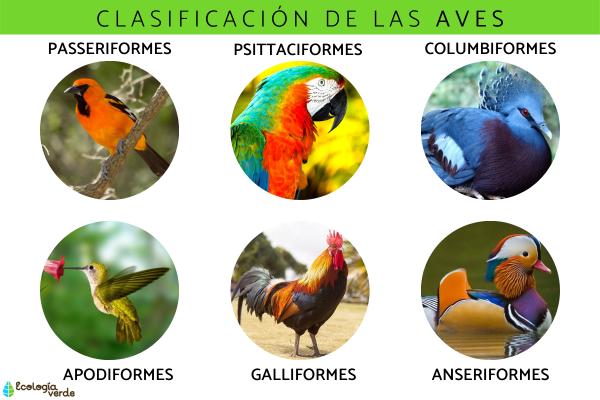
This article shows you some of the most common classifications of birds, from bird orders divided by taxonomy to types of birds divided according to different criteria, for example, based on their abilities in certain aspects or their relationships with other birds and humans.
Characteristics of birds
Classification of birds by their order
Classification based on bird anatomy
Classification based on bird activity
Classification based on bird diet
Classification of birds based on habitat
Classification of birds based on their relationship with other birds
Classification based on their relationship with humans
Regardless of order, family, or genus, all modern birds share the following characteristics:
Birds are a class of animals belonging to the kingdom Animalia, phylum Chordata, and subphylum Vertebrata.
They are heterotrophic, aerobic, warm-blooded creatures with a fast metabolism.
They are quadrupeds and bipeds. Their forelimbs evolved into wings, and although not all can fly, most can.
They have a four-chambered heart, a cloaca, and a hollow skeleton that facilitates flight.
Their bodies are almost completely covered in feathers, and they have no sweat glands.
They have toothless beaks, which they use to grab and swallow food.
Their feet are covered in scales, and most species have 4 toes on each foot.
They reproduce sexually (oviparously) through eggs, and more than 95% of species are monogamous for one or more breeding seasons.
We can classify birds in many ways: by their taxonomy, anatomy, locomotion, eating habits, habitat, and even by their relationships with other birds and humans.
Taxonomically, we can simply and effectively classify birds by their order. There are many orders of birds, but the most representative are:
Passeriformes or Passeriformes: is the order of birds with the most recorded species in the world. It consists of 5,700 to 6,500 species, and its members are usually called birds or songbirds. They are characterized by their small size, flight, nesting, and 4 toes on each foot. The most representative species of this order include canaries, sparrows, finches, crows, and goldfinches.
Apodiformes: an order consisting of hummingbirds, swifts, and swiftlets. It is the second most diverse order among birds with about 450 species currently. Its most notable feature is its small legs.
Oxpeckers: This order includes woodpeckers, toucans, and pseudo-woodpeckers. It is estimated that there are more than 340 to 450 species of birds in the order Psittaciformes. Most of the species are zygodactyls.
Psittaciformes or Psittaciformes: It consists of nearly 400 species of parrots and cockatoos. They are characterized by living in tropical and temperate regions, having thick and curved beaks and zygodactyl legs with claws. Macaws, budgerigars, lovebirds, and cockatoos belong to this order.
Columbiformes: Pigeons and doves belong to this order. It consists of about 350 living species of small to medium-sized herbivorous and flying birds and more than 10 extinct birds, of which the dodo stands out.
Charadriiformes or Charadriiformes: This order includes more than 350 species that live and feed near water. They include gulls, plovers, and puffins.
Galliformes or Galliformes: These are terrestrial fowl. This order includes nearly 300 species, including chickens, domestic turkeys, peacocks, partridges, quails, and guacharacas. They are not strong fliers, and most species have distinct sexual differences.
Anseriformes: These are aquatic fowl. This order includes more than 160 species, including barnacles, ducks, geese, and swans. Most are flying, migratory, and herbivorous.
Falconiformes: Over 300 species of diurnal raptors. They are characterized by excellent eyesight, hooked beaks, and long, sharp claws. This order includes hawks, vultures, and eagles, as shown in the picture below.
Strigiformes or Strigiformes: Nocturnal raptors, with more than 200 species. They have excellent hearing, dense feathers, and large eyes that are facing forward of the head. Owls and barn owls belong to this order.
Pelecaniformes: This order includes more than 70 species, including pelicans and herons. They have webbed feet with four toes on each foot and feed mainly on fish and shellfish.
Ciconiformes: This order consists of nearly 20 species of wading, waterfowl, and long-necked birds. Storks, flycatchers, and storks belong to this order.
Penguins (Sphenisciformes): These are flightless seabirds. All 17 existing species of penguins belong to this order.
Struthiomorpha: This group includes ostriches and other extinct flightless birds.
Flamingoes: This group consists of flamingos, flamingos, and their extinct relatives.
Some other important bird orders include: Gruiformes, Gruiformes, Carangiformes, Hermitiformes, Cuculiformes, Carangiformes, Carangiformes, Aptera, Capriformes, Tiger-shaped, Cibotiformes, Carangiformes, Carangiformes, Carangiformes, Carangiformes, and Crocodilians.
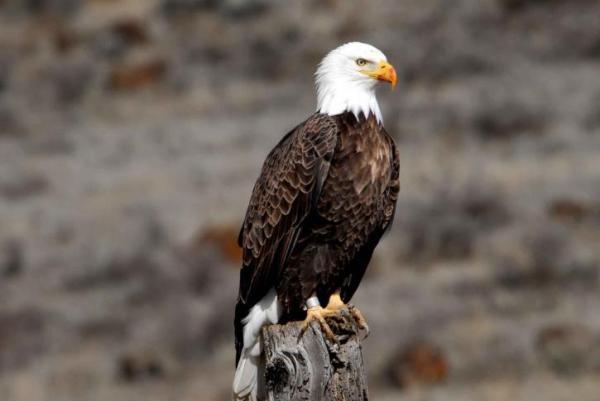
We can classify birds in many ways based on their anatomical features.
Depending on the size of its body, a bird may or may not be a bird. Some authors claim that if a bird is less than half a meter tall and weighs less than 1 kg, it is a bird.
As examples of birds, and therefore small species, we have the yellow weaver, the wild canary, and the Australian parakeet.
Examples of non-birds (i.e. large birds) include the blue-and-yellow macaw, the pelican, and the ostrich.
The shape and size of the beak can be used to infer a species' diet. There are many types of beaks, each with a specific function. Some types of spikes are:
Short, hooked beaks: characteristic of birds of prey and scavengers. They are used to tear meat into small pieces. Hawks and owls have short, hooked beaks.
Long, thin beaks: convenient for catching fish, mollusks, and other small invertebrates. They are typical aquatic fishing birds. Herons and storks have this type of beak.
Short, thick, sturdy pick: very useful in opening seeds and nuts. Bullfinches, finches, goldfinches, and hens have this type of beak.
Very thin and long beak: used to suck nectar from flowers. Hummingbirds are characterized by having this type of beak.
Broad and flat beak: Filter-feeding birds have broad and flat beaks that enable them to filter food from the water. Ducks, geese, and swans use broad and flat beaks to forage efficiently. You can see examples in the image below.
The number of toes, the presence of claws, and the size of the legs can determine how a species moves and whether it has the ability to swim, climb, run, or hunt.
Based on the number of toes, birds can be classified as two-toed (two toes on each foot, like ostriches), three-toed (three toes on each foot, like rheas), or four-toed (four toes on each foot, like passerines).
Based on the arrangement of their toes, birds can be classified as odd-toed, syndactyl, anterodactyl, heterodactyl, or pandactyl.
If it has sharp, downward-curving claws, it is a bird of prey (such as a hawk or owl).
If they have webbed feet with webs between the toes, they are waterfowl (such as ducks and penguins).
You can learn a lot about a bird by looking at its feathers. For example, based on the thickness and color of its feathers, one can tell whether it is a species that lives in a climate with very low temperatures (like penguins) or a species that uses its feathers to attract mates during mating season (like peacocks). Sexual dimorphism is also an indicator of a species' courtship and mating rituals. Birds of paradise, pheasants, and peacocks show significant sexual dimorphism.
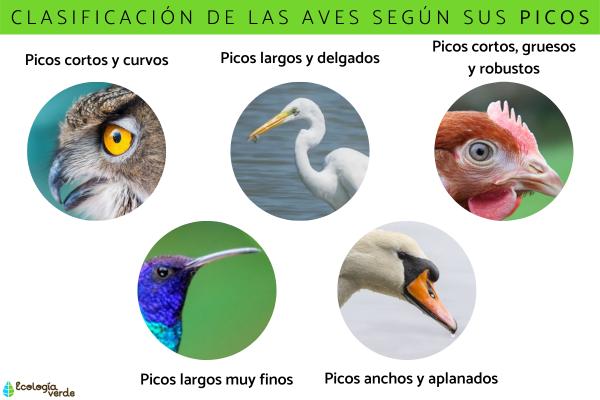
Birds can be flightless or non-flying, runners or non-runners, swimmers or non-swimmers, depending on how they move. For example:
Birds in the order Passeriformes, Psittaciformes, and Falconiformes are good at flying, not swimming.
Ostriches, emus, rheas, and cassowaries are flightless runners.
Penguins are flightless swimmers.
Ducks, geese, swans, and pelicans are both flying and swimming birds.
Discover 10 flightless birds here.
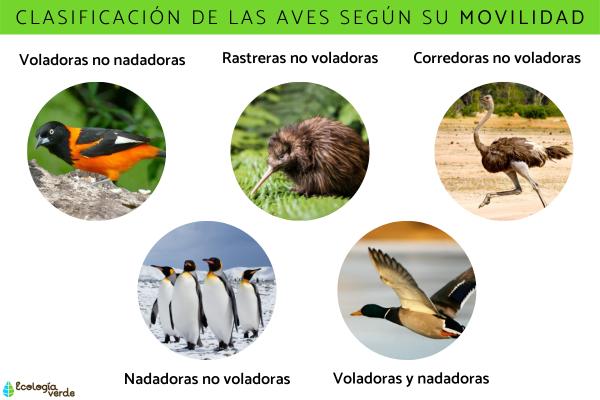
Depending on their diet, birds can be herbivores, carnivores, or omnivores.
Herbivorous birds, such as parrots, pigeons, and hummingbirds, feed on plants, fruits, grains, nuts, seeds, and/or nectar.
Carnivorous birds, such as hawks, vultures, and woodpeckers, can be insectivores, fishers, scavengers, and/or birds of prey, raptors, or raptors.
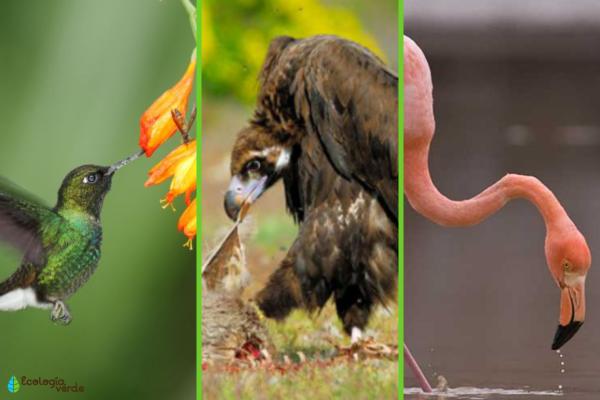
Here we classify birds according to their habitat:
Depending on whether they are permanent residents, they can be migratory birds (such as swallows) or resident birds (such as guacharacas). Read other articles about migratory birds: names and photos.
Depending on the ecosystem they live in, they can be terrestrial animals (such as ostriches), aquatic animals (such as penguins) or semi-aquatic or amphibian animals (such as ducks). Here we talk more about waterfowl: characteristics, species and names.
If they spend a lot of time at sea, they are called seabirds (such as gannets).
If they spend a lot of time in trees, they are called arboreal birds (like the parrots pictured below).
If they cannot fly and spend most of their time on the ground, they are called creeping birds (like kiwis and chickens).
If they prefer to live near or in human settlements, such as cities or suburbs, they are called urban birds (like pigeons, magpies, sparrows, and vultures).
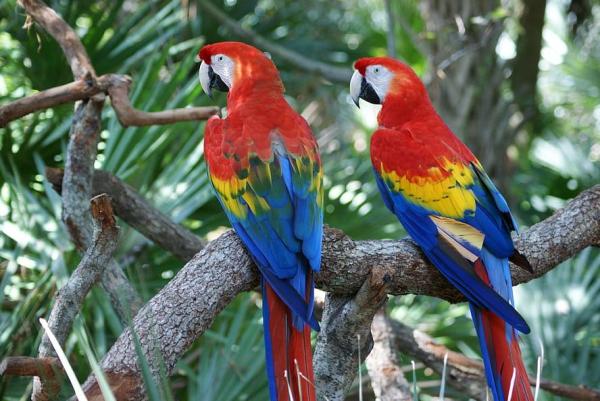
We can summarize the classification of birds based on their relationships with other birds using the following criteria:
The vast majority of birds are monogamous, and some species form lifelong relationships with one partner, such as swans and lovebirds. Non-monogamous birds tend to be polygamous and form harems, such as roosters, llamas, and peacocks.
When a bird likes to live and move in large groups with its own kind, it is said to be part of a flock, flock, or herd. Common queleas, ducks, and guinea fowl often travel in flocks.
Some social birds can live happily with other types of birds. This behavior is common among parrots, penguins, and ducks.

Another interesting classification of these animals is their relationship with us:
Birds that are kept in captivity for food or commercial purposes are called poultry. Chickens, turkeys, and ducks are all poultry.
When a bird has difficulty assimilating to domestic life, it is called a feral species, as is the case with hummingbirds and birds of prey.
When a bird species is endangered or critically endangered, it becomes a protected species, as is the case with the California condor and the green macaw.
Birds that are kept as pets are called songbirds and/or companion birds, such as the king parrot and the Australian parakeet. Here you can discover 13 species of singing birds.
Finally, we want to clarify that there are many more ways to classify birds. For example, they can also be divided into diurnal and nocturnal birds, depending on whether they are more active at certain times of the day or others, but there are more criteria for classifying species.
animal tags: Bird classification
We created this article in conjunction with AI technology, then made sure it was fact-checked and edited by a Animals Top editor.